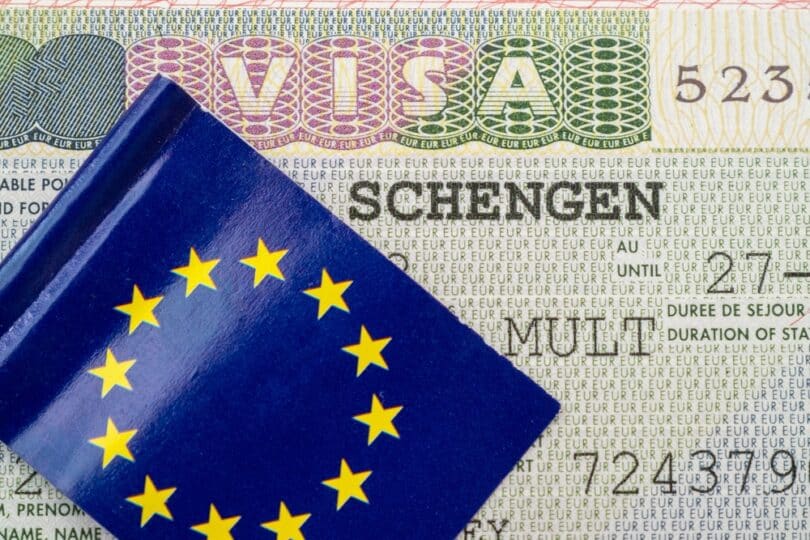In a move likely to impact travelers, the European Commission has proposed a significant rise in the fees for obtaining a Schengen visa.
If approved, the fee hike would see the basic cost for adults increase from €80 to €90 and for children from €40 to €45.
Schengen visas, available to non-EU citizens from countries not covered by the EU/Schengen area’s 90-day rule, such as South Africa, India, Pakistan, Sri Lanka, and China, could face these heightened fees.
Furthermore, the Commission suggests even steeper fees for countries deemed uncooperative in readmitting expelled citizens from member states.
Should the EU Council, comprising EU governments, find a lack of cooperation, the visa fee for citizens from such countries would escalate from €120/€160 to €135/€180.
The revision also impacts the maximum charges set for external service providers handling visa applications on behalf of member states. This charge, usually half the standard fee, could rise from €40 to €45.
However, the fee for extending a Schengen visa would remain at €30.
Revisions and Consultations
Every three years, the EU Commission evaluates the necessity of adjusting fees based on objective criteria such as the EU inflation rate and civil servants’ salaries in member states.
Following a meeting with member state experts in December, where the revision garnered significant support, the Commission published its proposal on February 2nd.
Open for consultation until March 1st, the proposal could see adoption by the Commission, entering into force 20 days after publication in the Official Journal of the European Union.
Comparison with Other Countries
The Commission argues that even with the increase, Schengen visa fees remain relatively low compared to other nations. For instance, visas for the USA cost €185 or €172, for the UK starting from £115 (€134), for Canada at $100 plus $85 for biometrics, or €130, and for Australia at $190, equivalent to €117.
Digitalization of Schengen Visas
Alongside the fee adjustments, the EU plans to introduce digital-only Schengen visas, allowing online applications irrespective of the intended Schengen country. This digital visa would replace the current passport stickers.
According to the European Commission, the digital platform is slated to commence operations in 2028.
What Schengen Visa Would One Need
Schengen visas permit stays for tourism or family visits, not work, in 28 European countries for up to 90 days within six months. Business travelers apply for Schengen business visas.
Those intending to stay longer or work require visas specific to the country they plan to visit. Citizens from countries not benefiting from the ’90-day rule’, such as those listed earlier, require Schengen visas.
However, citizens of certain non-EU countries, including Britons, Americans, Canadians, and Australians, can spend up to 90 days within every 180 in the Schengen area without requiring a visa.
Ireland, Cyprus, Bulgaria, and Romania are not part of the Schengen Convention.
What is Schengen?
The Schengen Area, established through the Schengen Agreement, represents a significant advancement in European integration, fostering seamless travel and cooperation among its member states.
The Schengen Agreement, signed in 1985, is a landmark treaty among European countries aimed at abolishing internal border controls. Named after the town in Luxembourg where it was signed, the agreement facilitates the free movement of people and goods across participating nations.
Comprising 27 European countries, including Austria, Belgium, France, Germany, and others, the Schengen Area operates as a border-free zone where internal borders are abolished, allowing for unrestricted movement of people and goods. This arrangement plays a crucial role in promoting economic growth, facilitating tourism, and enhancing cultural exchange within the European Union.
Through the elimination of passport controls at internal borders, the Schengen Area symbolizes the spirit of unity and collaboration among its diverse member nations, shaping a more integrated and interconnected Europe.
Which countries are members of Schengen in 2024?
Certainly! Here’s a list of all the Schengen countries, including Croatia, along with their joining dates:
- Austria (Joined: 1995)
- Belgium (Joined: 1995)
- Czech Republic (Joined: 2007)
- Denmark (Joined: 2001)
- Estonia (Joined: 2007)
- Finland (Joined: 2001)
- France (Joined: 1995)
- Germany (Joined: 1995)
- Greece (Joined: 2000)
- Hungary (Joined: 2007)
- Iceland (Not an EU Member, but joined Schengen in 2001)
- Italy (Joined: 1995)
- Latvia (Joined: 2007)
- Liechtenstein (Joined: 2011)
- Lithuania (Joined: 2007)
- Luxembourg (Joined: 1995)
- Malta (Joined: 2007)
- Netherlands (Joined: 1995)
- Norway (Not an EU Member, but joined Schengen in 2001)
- Poland (Joined: 2007)
- Portugal (Joined: 1995)
- Slovakia (Joined: 2007)
- Slovenia (Joined: 2007)
- Spain (Joined: 1995)
- Sweden (Joined: 1995)
- Switzerland (Not an EU Member, but joined Schengen in 2008)
- Croatia (Joined 2023)
(eTN): Would Raising The Schengen Visa Fees Favor EU? | re-post license | post content























